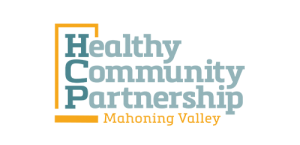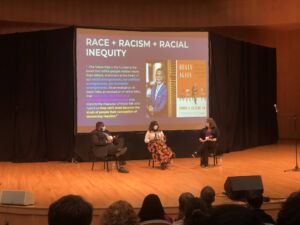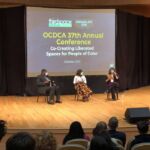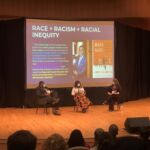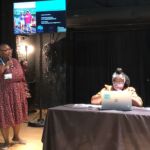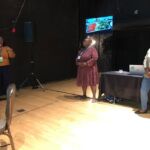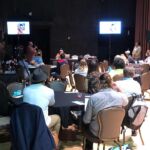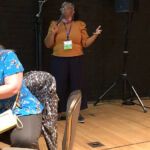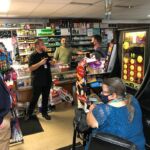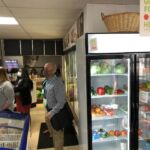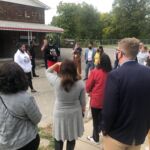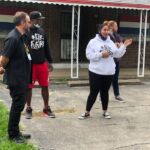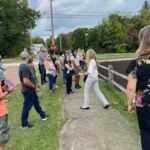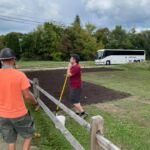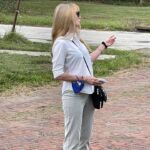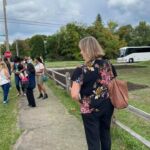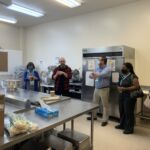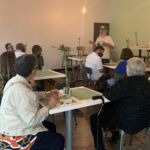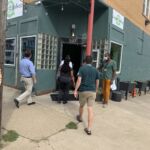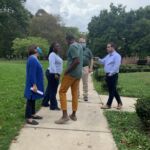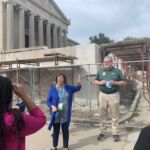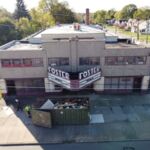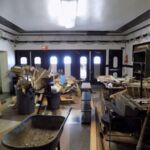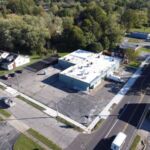October 2021 Moment of the Month: Healthy Community Partnership Members Participate in the Ohio Community Development Corporation Association’s Annual Conference
Several HCP members presented, participated in conference activities and made connections between public health and community development.
Many multi-sector collaborations across the country have been working together to recognize and reckon with the unsettling fact that what goes on outside the walls of a healthcare facility (ex: housing, employment, education, food, transportation, public policy, social and institutional norms, etc.) has an outsized impact on our health. When accounting for social and environmental conditions as well as the choices we have, or don’t, as a result, 80% of our health and wellbeing are tied to these factors.
Countless coalitions and collaborations have coalesced around these issues well before the pandemic. However, a slight silver lining over the last nearly two grueling years is more hearts and minds have been opened to see, feel, and understand these connections—and have inspired action to address them.
The Partnership was created specifically for this purpose—to convene the community to identify challenges and solutions to health disparities and inequities affecting residents in the Mahoning Valley region. There are many incredible partners within our network—and we hope to continue adding more—but two sectors that have been a long anticipated, much needed wedding waiting to happen are community development and public health.
Public Health is defined as:
The science of protecting and improving the health of people and their communities. This work is achieved by promoting healthy lifestyles, researching disease and injury prevention, and detecting, preventing and responding to infectious diseases. Overall, public health is concerned with protecting the health of entire populations. These populations can be as small as a local neighborhood, or as big as an entire country or region of the world. (Center for Disease Control & Prevention Foundation)
As Public Health carries out the mission through local health departments, Community Development often happens through organizations called Community Development Corporations. The mission of Community Development Corporations (CDC) is to:
Support and revitalize communities, especially those that are impoverished or struggling. [CDCs] can also be involved in a wide range of community services that meet local needs such as education, job training, healthcare, commercial development, and other social programs. (National Alliance of Community & Economic Development Associations)
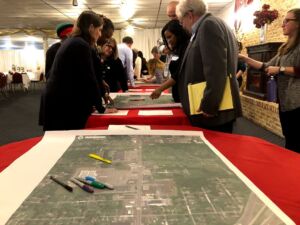
HCP members put their heads together to solve local transportation challenges to improve health, quality of life, and access to economic opportunities
When you stop and think about it, it’s obvious that these two sectors must be in a close relationship with each other in order to achieve their missions—each is one half of the whole. How could Public Health “protect and improve the health of people and their communities” without CDC’s “support[ing] and revitaliz[ing] communities, especially those that are impoverished or struggling”? They are each one hand doing the work to help and heal our communities, which is always most impactful and effective when done in concert as opposed to solo performances.
Relationship building is always a process, and one that no matter the setting or situation requires three essential elements: trust, open and honest communication, and love. Coalition building is no exception. It has been exciting to watch relationships bud, blossom, and bloom during the short period the Partnership has been active. For the first time in many cases, there is a sustained level of conversation and collaboration between community development and public health that is exciting and inspiring. Plans developed, investments made, and decisions carried out will be done with more comprehensive input, resulting in more comprehensive outputs and outcomes for health as well as economic opportunity. And recently, there was an opportunity for the whole community—and guests from across the state—to witness this beautiful marriage unfolding.
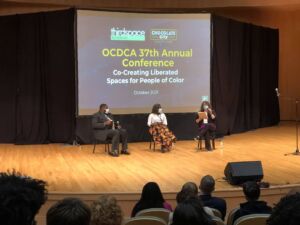
Left to Right: Jamar Doyle, OCDCA Board Vice President; Evelyn Burnette, Co-Founder ThirdSpace Action Lab; Emily Seibel, OCDCA Board President
October 6-8, the Ohio Community Development Corporation Association (OCDCA) hosted their 37th Annual Conference here in the Mahoning Valley. Several Partnership members served on the Host Committee, which was responsible for assisting OCDCA staff to organize sessions and tours as well as provide volunteers to assist conference attendees. Others participated as panelists and speakers during the sessions and tours. It was three days of excitement, engagement, and encouragement with a little bit of shameless self-advertisement—it’s not every day that the Mahoning Valley gets to show off to sibling cities and communities around the state.
Perhaps the most impactful part of the conference was keynote speaker, Evelyn Burnette, co-founder of ThirdSpace Action Lab, and her presentation: “Co-Creating Liberated Spaces for People of Color.” Ms. Burnette shared stories and reflections about racism’s impact on economic opportunity, resident health, and community vitality for people of color in Cleveland and Youngstown–her hometown and where her proud parents still reside.
She shared her perspectives on the progress made with recent investments and redevelopment of downtown, which is remarkable not only because of the physical transformation of the space but also the social transformation:
“What was most striking was not only the physical development of the building… But there was a lot of diversity of people sitting outside.”
Creating spaces that create a sense of belonging is a critical component of ThirdSpace’s work. “Third Spaces” are the physical places people occupy that aren’t home (first space/place) or work (second space/place)–they are the everywhere else and where people discover themselves–their unique identities, beliefs, and values. So, of course CDC’s have a very important role in the development and redevelopment of third spaces that instill and inspire a sense of belonging.
“The role of the CDC is to introduce a lifelong resident, or re-introduce a lifelong resident, to their city.”
And, to facilitate this reintroduction in a way that encourages equitable engagement and investment in people and place for the long term. Since social and environmental factors have a significant impact on health, creating cohesive communities where everyone feels connected, like they belong, is a shared priority between community development and public health professionals.
Below are session and tour descriptions that Partnership members participated in and demonstrated the interconnectedness of supporting and revitalizing communities and protecting and improving health.
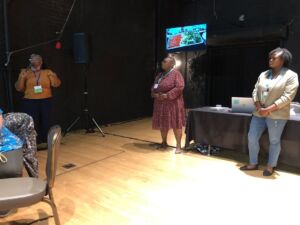
Carmella Williams, Sophia Buggs, and Christian Bennett-Mosley facilitating Q&A at the end of the session
> The Business of Food Justice: The Mahoning Valley Community Store Initiative
Carmella Williams, Intentional Development Group
Sophia Buggs, Mahoning County Food Access Coordinator
Christian Bennett-Mosely, Trumbull County Food Access Coordinator
According to Feeding America, 1 out of every 8 Ohioans experience hunger. These unsettling numbers increase to 1 out of every 6 Ohio children regularly experiencing not having enough to eat. Simultaneously, the over $20 million distributed to Ohio families through the Supplemental Nutrition Assistance Program (SNAP) has helped to generate over $34 million in economic activity. When communities come together to find ways to feed families healthy, affordable foods, it is not only the right thing to do morally, it is the right thing to do economically. The Mahoning Valley Community Store Initiative is prioritizing food access, small business support, and social equity. The Food Access Coordinators leading the effort have been cultivating relationships with local business owners, growers, producers, distributors, non-profit partners, and residents to bring food into neighborhoods and secure resources to support Community Store owners. This session will provide an overview of the Mahoning Valley Community Store Initiative, progress and success to date, and plans for future growth.
This session was especially special because the Partnership had the opportunity to work with Deonte “Tae” Stubbs for a 9 week fall internship during this time. Tae’s time and talent were put to work developing compelling visual content to better communicate the Partnership’s priorities. His first successful undertaking was creating a Mahoning Valley Community Store Initiative video for this conference. Watch the full video below and scroll down to see a photo gallery from the Mahoning Valley Food Access Team’s presentation.

Peace Park pollinator garden installation, an example of the effort to revive neighborhood greenspaces throughout Youngstown.
> Fresh Starts SW: Collaborators are creating new opportunities for all residents to embrace technology, expand their businesses, and cultivate a healthier environment. This tour will start on Youngstown’s South Side at Oak Hill Collaborative, with its free-access maker spaces, podcast studio, and computer coding courses. Additional stops will include flexible-space buildings that Western Reserve Port Authority renovated for up-and-coming businesses; a commercial greenhouse on the West Side that will reopen as a social enterprise by local nonprofits; and a glimpse of a maple syrup-making operation that pours revenue and pride into the Rocky Ridge Neighborhood Association.
One of the stops on the tour was at Peace Park, off or Oak Hill Avenue on the Southside of Youngstown. This is one of multiple sites that the Mahoning County Land Bank, Youngstown Rotary, and Partnership members assisted in the installation of pollinator gardens over the spring. Photos from the stop and a video of group seed toss are in the gallery below. Video and photos provided by Dionne Dowdy, Executive Director, United Returning Citizens.

Sonnie Provitt and Deryck Toles from Inspiring Minds share their vision for a whole healthy neighborhood starting with a community led grocery store.
> Building a Better Warren: This tour will be conducted by Trumbull Neighborhood Partnership and the Healthy Community Partnership to show off nearby Warren, the Mahoning Valley’s second largest urban center. The tour will highlight some of the city’s historic marvel, and also focus on the importance of partnerships when addressing challenges with blight remediation, food access, and the general quality of life in one of Ohio’s most historic small legacy cities. After exploring the city, the tour will recap at Modern Methods Brewery before returning the twenty-five minutes back to Youngstown.
Scroll down to view a photo gallery from the Building a Better Warren Tour featuring Mr. Mike from Lil’ Mac’s Community Store and Deryck Toles and Sonnie Provitt from Inspiring minds, who delivered an inspiring overview of their vision and plans for a solution to healthy food accessibility in Warren.
> The Fabric of Our Community: This bus riding/walking tour offered by Youngstown CityScape will show off our
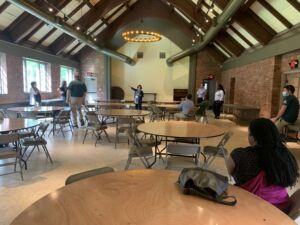
OCDCA 2021: The Fabric of Our Community Youngstown Tour visits recently renovated Wick Park Pavilion
city’s “cultural corridor,” historic Wick Park, and North Side institutions and neighborhoods. Experience the rich fabric of our community including art and beautification projects, small business development, and a kitchen kitchen incubator—with a chance to taste a local treat!
Scroll down to view a few highlights from this tour celebrating milestones in the movement to create a healthy, food-focused neighborhood on Youngstown’s Northside.
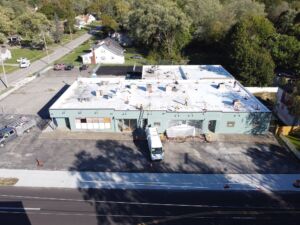
One of the stops on the Glenwood Corridor Tour was YNDC’s renovation of a small plaza that will be the home of a new fresh food market and restaurant.
> Incremental Neighborhood Stabilization in the Idora Neighborhood and Glenwood Avenue Corridor: The tour will stop at multiple locations in the Idora neighborhood and along the Glenwood Avenue commercial corridor including: a vacant home undergoing renovation, a recently completed new home, a small monastery that has been renovated into apartments and community space, a historic retail plaza undergoing renovation and including a restaurant and a fresh market focusing on produce accessibility for low-income residents, and ending at a mixed use building that includes a non-profit operated coffee shop and café. The tour will also pass by a number of other sites including multiple vacant land greening and management projects, a small neighborhood park constructed by the neighborhood, a recently acquired vacant and former XXX theater, and other ongoing projects. The tour will provide details of how the neighborhood wide effort began with the Idora Comprehensive Neighborhood Plan and has continued since with ongoing incremental improvement that has resulted in a dramatic decrease in vacancy and other positive indicators.
A few highlights from this tour are also in the gallery below.
- OCDCA 2021: Evelyn Burnett Keynote Address
- OCDCA 2021: Evelyn Burnett Keynote Address
- OCDCA 2021: Business of Food Justice
- OCDCA 2021: Business of Food Justice
- OCDCA 2021: Business of Food Justice
- OCDCA 2021: Business of Food Justice
- OCDCA 2021: Business of Food Justice
- OCDCA 2021: Building a Better Warren Tour
- OCDCA 2021: Building a Better Warren Tour
- OCDCA 2021: Building a Better Warren Tour
- OCDCA 2021: Building a Better Warren Tour
- OCDCA 2021: Building a Better Warren Tour
- OCDCA 2021: Building a Better Warren Tour
- OCDCA 2021: Fresh Starts SW Youngstown Tour
- OCDCA 2021: Fresh Starts SW Youngstown Tour
- OCDCA 2021: Fresh Starts SW Youngstown Tour
- OCDCA 2021: Fresh Starts SW Youngstown Tour
- OCDCA 2021: The Fabric of Our Community Youngstown Tour
- OCDCA 2021: The Fabric of Our Community Youngstown Tour
- OCDCA 2021: The Fabric of Our Community Youngstown Tour
- OCDCA 2021: The Fabric of Our Community Youngstown Tour
- OCDCA 2021: The Fabric of Our Community YoungstownTour
- OCDCA 2021: Incremental Neighborhood Stabilization in the Idora Neighborhood and Glenwood Avenue Corridor
- OCDCA 2021: Incremental Neighborhood Stabilization in the Idora Neighborhood and Glenwood Avenue Corridor
- OCDCA 2021: Incremental Neighborhood Stabilization in the Idora Neighborhood and Glenwood Avenue Corridor
- OCDCA 2021: Incremental Neighborhood Stabilization in the Idora Neighborhood and Glenwood Avenue Corridor
